JAGUAR CACAO
The Best Kept Secret of the Amazon Rainforest
The Amazon’s Best Kept Secrets
Discovery Channel – Welcome to the Amazon Rainforest
With an area of approximately 5,5 million km², the Amazon rainforest is one of the most intense ecosystems on Earth. In addition to the already known amazing biodiversity, there are many more plants, trees, fruits and flavours yet to be discovered. In this living laboratory, new plant species are now being identified almost every week.
Amazon Rainforest Superfoods
The indigenous inhabitants of the Amazon Rainforest master their plants and fruits. Not only do they know whether these plants and fruits are edible, nutritious and flavourful; they are also very well aware of the possible beneficial health characteristics – antioxidant, anti-inflammatory, restorative,… Some of these exotic fruits and flavors have since been commercialised and better known to the general public as superfoods (think Acerola, Açaí berries, Cupuaçu, Guaraná, ..). Others have only recently been picked up by foodies and health geeks.
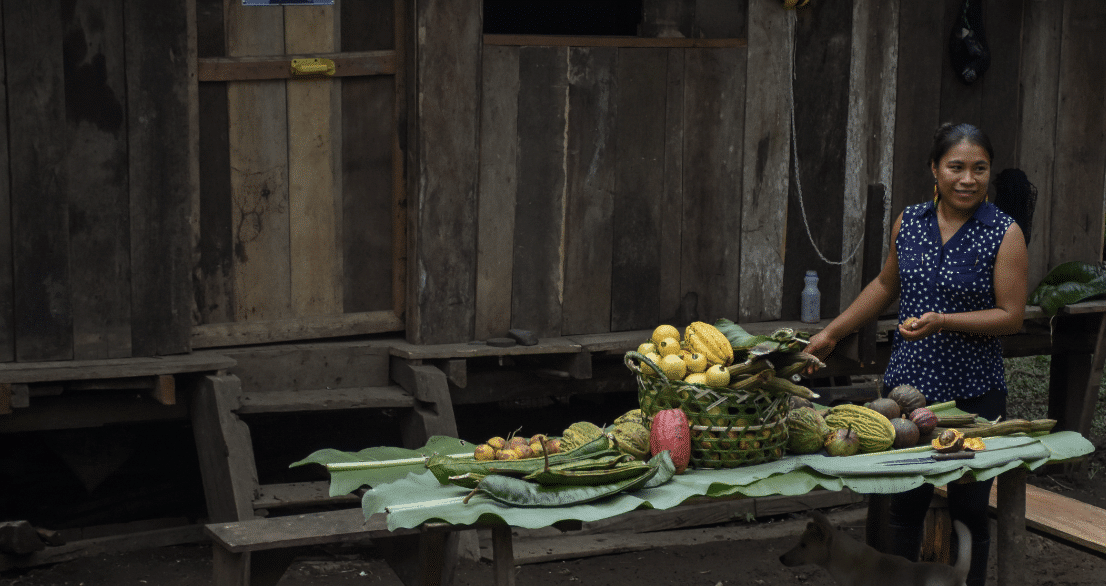
The Best Kept Secret of the Amazon Rainforest – Jaguar Cacao
More specifically, the cacao aficionados among us will enjoy hearing all about the Amazon’s best kept secret: ‘Theobroma Bicolor’ or ‘Jaguar Cacao’. Theobroma bicolor is the only species in the Rhytidocarpus section of the Malvacea family, and the ‘cousin’ of Theobroma Cacao. This tree grows up to 30 m high in forest areas; it used to grow abundantly in the Amazon, now it is scarce and hard to find.
Ancient Native Mesoamerican Cacao Ceremonies.
Since prehistoric times, Theobroma Bicolor or Jaguar Cacao has been used for both ritual and health purposes. In these pre-Columbian civilisations, cacao was significant for religious customs (ensuring a good fate to the gods) and beliefs surrounding death, fertility, and economic exchange.
Feasting with Foam
It turns out that, despite the central role of traditional cacao (Theobroma Cacao) we know in the life of pre-Columbian cultures, Theobroma Bicolor also played an important role in symbolism. Theobroma Bicolor is said to be that important addition, making the cacao drinks more… ‘foamy’.
Many histories and ancient images describe and testify that the whipped foam in the drink was seen as a feature attesting to its excellent quality. However, this foam could not easily be obtained from Theobroma Cacao alone in the drink, so most likely Theobroma Bicolor was added to achieve an effect worthy of today’s cappuccino.

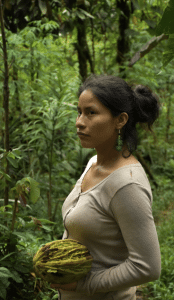
Theobroma Cacao’s lost Cousin – ‘Theobroma Bicolor’ aka Jaguar Cacao
Pleased to Meet You – Hope you Guess my Name
Native to tropical America and probably originating in the Amazon region, Theobroma Bicolor is mainly found in Colombia, Brazil, Ecuador and Peru under various names here and there. This Jaguar Cacao, Macambo, Cacao Blanco, Cacao Silvestre, Albino, Balamte, Pataxte, Patasmuyo or its scientific name ‘Theobroma Bicolor’ is the long lost ‘cousin’ of the Theobroma Cacao we all know and love.
Theobroma Bicolor is also known as Jaguar Cacao, because somehow the white-ish green dry pod surface resembles a jaguar’s fur/pelt – hence ‘Jaguar Cacao’.
The jaguar also occupies a unique place in Mayan cosmology. It inhabits the first level of heaven. In addition, jaguars are associated with the night, caves and the underworld; in other words, the same complex of symbols as cacao. And as a creature in the Mayan universe, jaguars represent the most powerful spiritual companion.
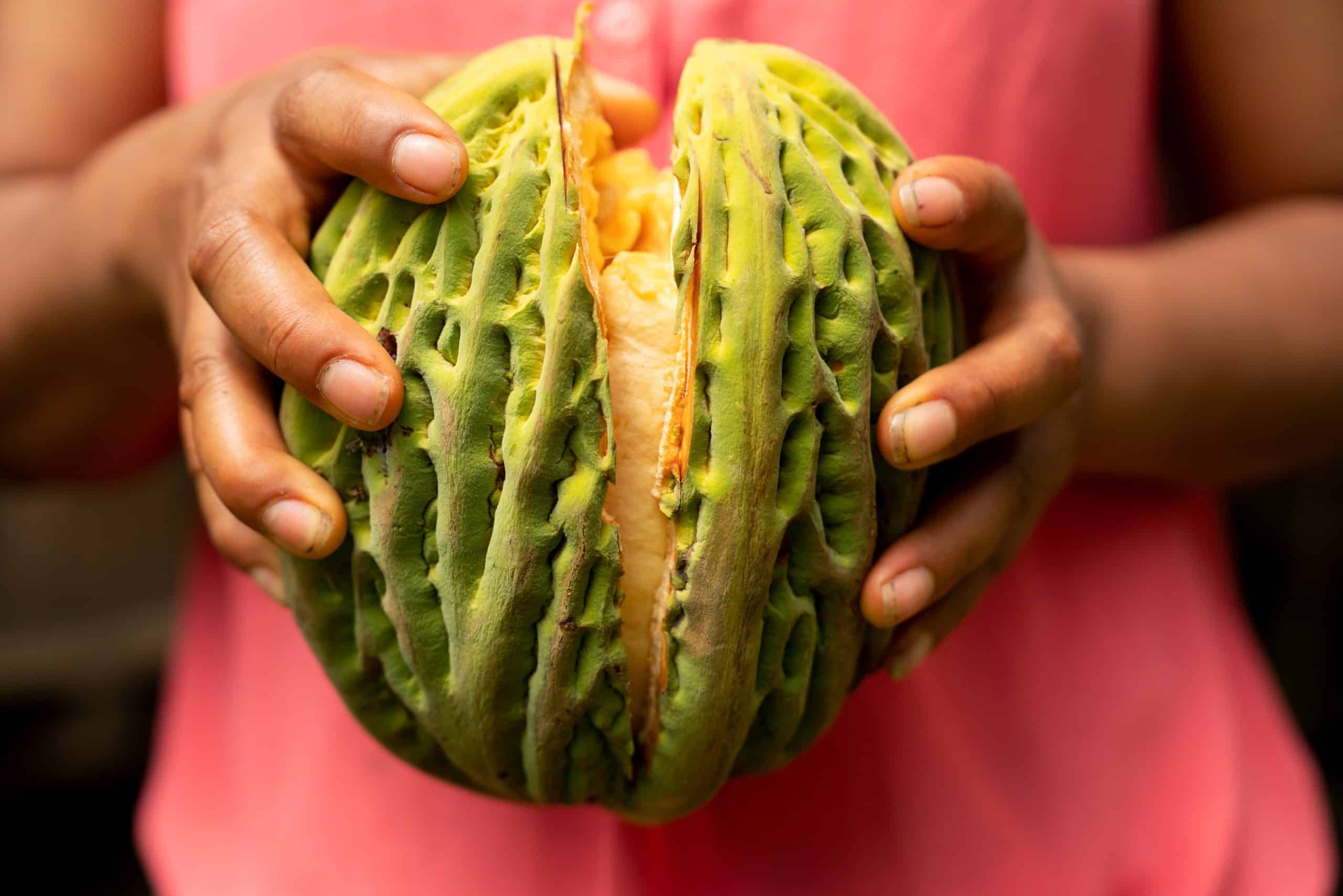
It’s a Family Affaire : ‘ Theobroma Cacao’s & ‘Theobroma Bicolor’
Theobroma Bicolor is a somewhat lost cousin of Theobroma Cacao. And because they come from the same botanical family, there are many similarities, but also differences. Same same, but different.
So let’s go through some amazing facts & figures:
- The Jaguar Cacao tree and the Cacao tree are as different as night and day. The Jaguar Cacao tree grows tall and very high (it can reach heights of 25-30 meters tall in the wild) and it’s leaves are much larger. You will rarely see its flowers since they are so high off the ground.
- While cacao can flower all year long, the Jaguar tree only flowers in the dry season and produces only one inflorescence per bud.
- The ‘fruit’ also looks very different. The green pods are serrated, with irregular ridges and rough edges, giving the pod a rough appearance and texture. The structure of a Jaguar Cacao pod also somehow resembles the ‘fur’ of a jaguar – hence ‘Jaguar Cacao’.
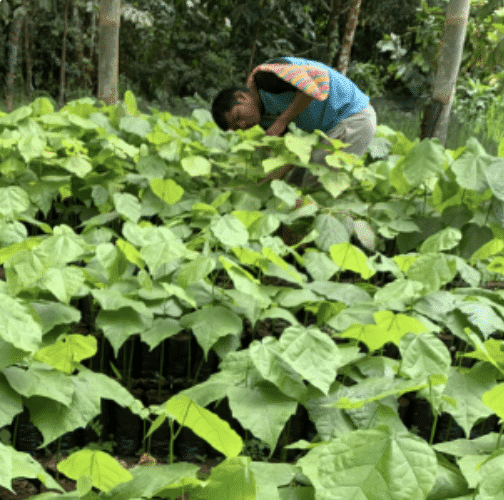
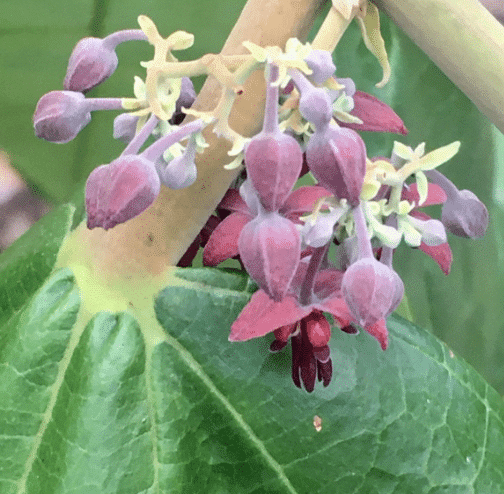
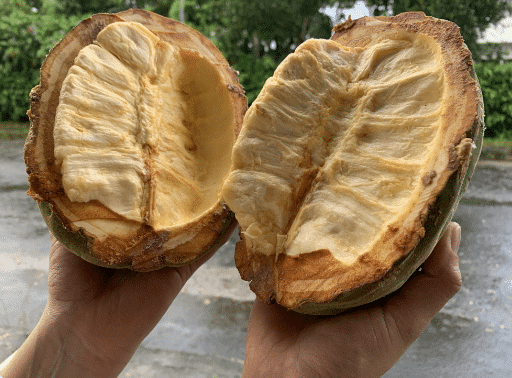
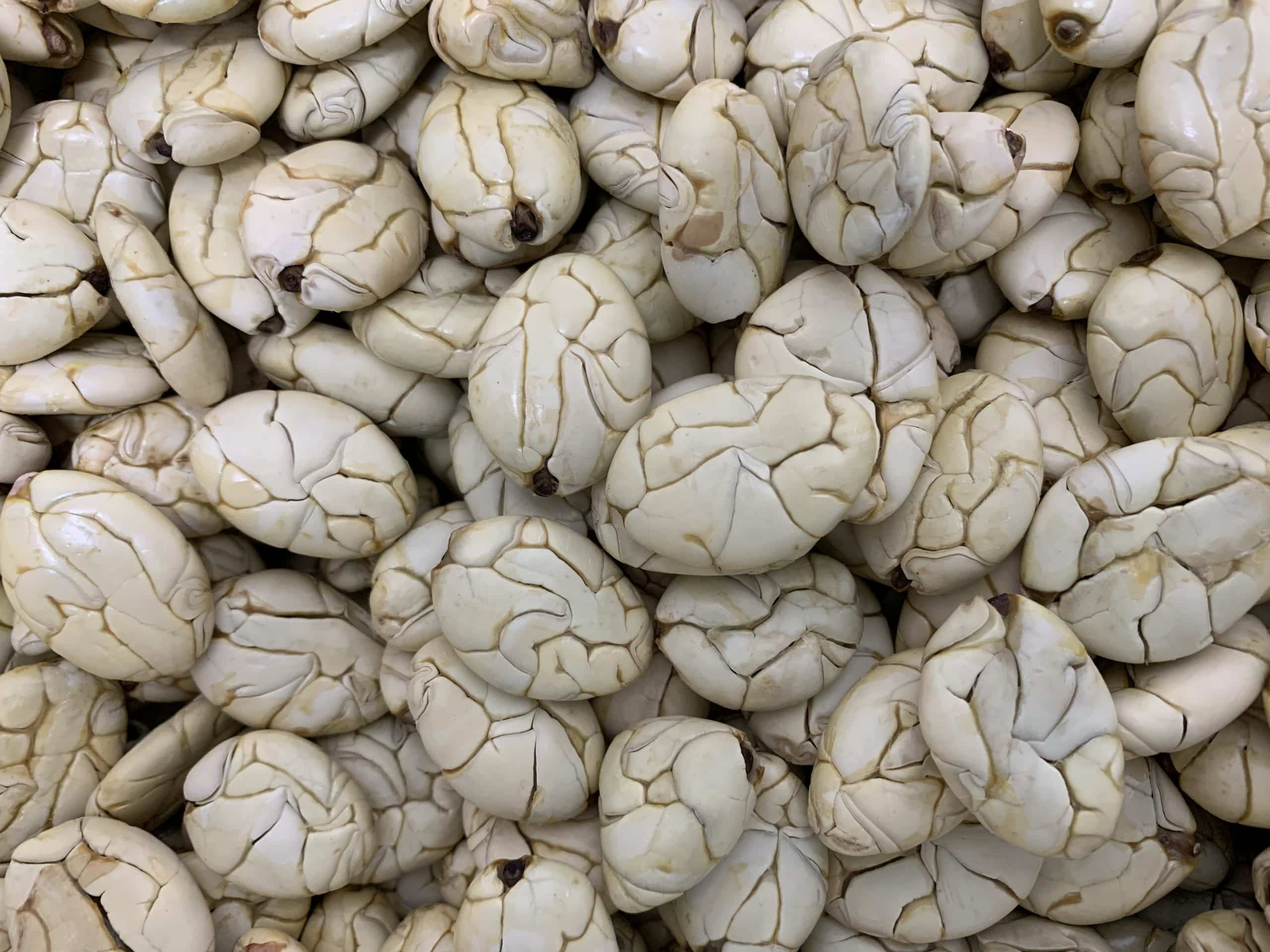
- Unlike Cacao, Jaguar Cacao pods fall from the tree when ripe, allowing natural reproduction without human intervention. The pods emit a strong fragrance for one to two weeks after they have fallen from the tree.
- The Jaguar Cacao pods are picked up from the ground; this way ensures that you get the right indication of the sweet and delicate taste of the pulp. Harvesting when they are hanging on the tree and not yet ripe can give a very special -not necessarily the best- aroma and taste experience…
- When opening a Jaguar Cacao pod, you find about 35 – 40 seeds inside, the pulp is much more ‘fleshy‘ than regular cacao. Immediately, some delicate aromas and flavours emerge.
- The beans are white to cream-coloured, slightly flattened, oval-shaped and approximately 3 cm long. The beans contain no anthocyanin, explaining it’s “white” colour, and low bitterness. Their surface is convoluted and fissured, leading to frequent comparisons to tiny brains.
- The beans are covered with a thick ‘skin’. As with Theobroma Grandiflorum, separating skin and beans can be a bit of a nightmare…
- The taste seems to be at its best when no fermentation takes place (and therefore no browning process). This preserves the white color when the beans are dried.
- Jaguar Cacao contains (about 20%) less fat but has more unsaturated fat than regular Cacao, more fiber and more protein. With an antioxidant capacity slightly higher than that of regular Cacao, a lower polyphenol content, a very low caffeine content and some theobromine, Jaguar Cacao is a rightly called a ‘superfood’ with nutritional value.
- The seeds of Jaguar Cacao are actually a healthy snack with 3 times more protein than macadamia nuts, twice as much fiber than almonds and 1.3 times more Omega 9 than walnuts. It contains ‘theobromine’, a component also found in cacao, that helps reduce blood pressure and aids muscle relaxation.
- In a context where a chocolate bar is supposed to taste like Cacao, Jaguar Cacao is the outsider. Some professionals say that the taste is a cross between cacao butter and the mildest Porcelana* you can imagine. Simply put, the taste of Jaguar Cacao is smooth and sweet with aromatic notes ranging from tropical fruits (mango, papaya,..) to nutty and milky flavours with a hint of saltiness.
Our Superfood Selection from the Ecuadorian Amazon
The Jaguar Cacao that we offer, grows in the South Ecuadorian rainforest. Very close to where the oldest remains of the Mayo-Chinchipe culture were recently discovered (and where pottery found on the site marked with the traces of cacao proved that cacao was domesticated there – and some 5 500 years earlier than previously thought).
Generations of indigenous farmers from the Kichwa and Shuar nations have been tending and harvesting these prolific trees for decades. Their native farms – called chakras in the local Kichwa language – are indistinguishable from the rainforest.
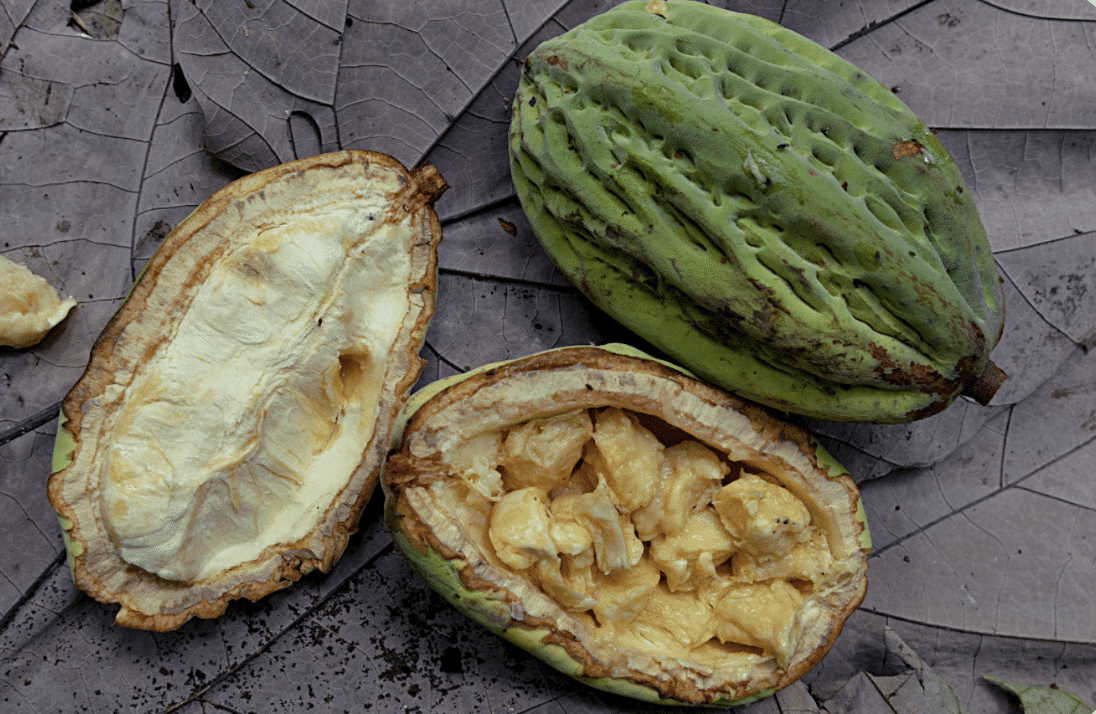
Until recently, the harvest and consumption of Jaguar Cacao had declined. By selling some of their crops that had previously been rotting on the forest floor, the women farmers were able to boost their income. Slowly and carefully -and with the support of nurseries and tree planting programs- they restored these abandoned trees and incorporated a new generation of Jaguar Cacao into the mix of their chakras.
Within days of these pods falling from the tall trees, the women farmers split open the ripe pods with a hard blow from a machete. The naked seed is seperated from the tight casing of the surrounding pulp and seed coat, and then dried. The beans are then roasted by hand, and finally the beans are carefully shelled by hand. Finally, the beans are vacuum packed at the origin.
This local approach and careful processing not only preserves the unique taste of the beans, but also creates employment for the indigenous women.
Let’s Get Nuts with New Flavours & Recipies !
Jaguar Cacao beans are shelled by hand, roasted at low temperatures and vacuum packed. They come in 10 kg boxes, Ready & Easy to Use !
Tasting Note :
You’ll notice an unique texture with a flaky crunch that breaks into delicate shards. The whole experience reminds us much more of ‘nuts’ than ‘Cacao’. Their taste is mild but rich, with nutty flavours reminiscent of cashew, pistachio and almond, and a slight sweetness. We also found notes of melon and butter, and a pleasant salty touch.
Possible applications and creations:
as ‘CHOCOLATE’ in pure or mixed version
The ‘white bars’ will certainly surprise any chocolate lover
-> !!! Please remember it has half the ‘fat content’ of cacao and more fiber, so adding cocoa butter (or another fat) for conching and melaging is recommended.
-> When processed like cacao beans for real chocolate, only the nutty Jaguar Cacao beans can create a delicate ‘white’ bar. Or, processed together with cacao, can lead to a smooth, milky bar, dairy-free. Great for vegans!
like a ‘NUT’, cover it with Jaguar couverture or chocolate couverture
-> Whole beans can also be coated in chocolate, playing with the contrast of these two related beans from the same cacao family
-> The nibs, with their nuttiness, light fruitiness and crunchy texture, can also be used in chocolate bars
like a ‘NUT’, but in an oldskool, traditional way
-> Simply roast the bean, salt it and eat it like a nut. Great snack and matches with any kind of ‘aperitivo’
->The white colour and nutty and slightly mineral taste allow for a wide range of uses to drive creative minds crazy…
as a ‘NUT SUBSTITUTE’ -> in any culinary recipes that calls for ‘nuts’
-> While not a nut in the true botanical sense (but rather a seed), Jaguar Cacao beans are spectacular in any recipe that calls for nuts to add extra flavour or texture. Functionally, the use and application are the same.
-> Chefs use it in ice cream, pies, cakes, biscuits, pralines, marzipan, soups, sauces. pesto,…
as a ‘DRINK’
-> vegan drinks are trendy: in the midst of almond milk, hazelnut milk, chocolate drinks, … a superfood Jaguar drink will definitely stand out! Cheers !

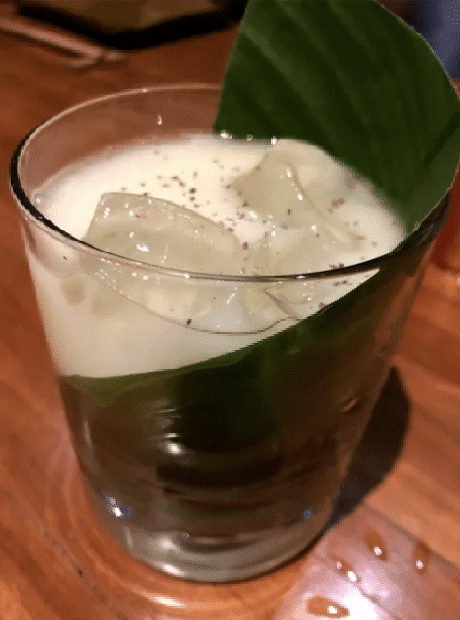
KUDO’S, CREDITS & INSPIRATION
* Porcelana; the name is Spanish for “porcelain,” a reference to the stark white color of the seeds borne in their small, pale green pods. Porcelana is one of the cultivars of the the Criollo group. Porcelana is perhaps one of the best-known ultra-rare cacao varietals, only grown in a small region of Venezuela and Colombia. It’s become one of the most prized and expensive cacaos in the world thanks to its near complete lack of bitterness and delicate chocolaty flavour.
**Chakra’s are biodiverse agroforestry systems that mimic the forest’s natural composition. This traditional method of farming has been used primarily by the indigenous Amazonian farmers, and mostly by the Saraguro and Shuar women of the area. They are believed to hold the wisdom of the Chakra cycle and also the cultivation of all crops and plants. By using the Chakra system, they intercrop cacao with a multitude of other trees and plants that all interact with each other. It provides not only subsistence crops and food security, but it is also an extension of forest habitat for rainforest flora and fauna. This sort of cultivation forms a landscape that resembles to a mosaic, which is economically productive and ecologically friendly to the biodiversity of the area. Today farmers are still applying this ancient technique that has been passed on for generations from the traditional indigenous communities.
Photo Credits – Canopy Bridge
Science Direct – Potential of the amazonian exotic fruit for biorefineries: The Theobroma bicolor case
PNAS – New light on the use of Theobroma cacao by Late Classic Maya
Slow Food Foundation for Biodiversity – The Ark of Taste – Macambo
Research net – Feasting with Foam
The New Gastronome – Cacaos Unlucky Cousin
Mad for Food & Adventure – Cacao Juice
SILVA CACAO – Ecuador Zamore Chinchipe
SILVA CACAO – Unveiling the Earliest Domestication of Cacao – Ecuador
Composition Jaguar Cacao (per 100g)
| Total fats | 20 g |
| Total carbohydrates | 47 g |
| Fiber | 7 g |
| Protein | 20 g |
| Moisture content | ~3% |
